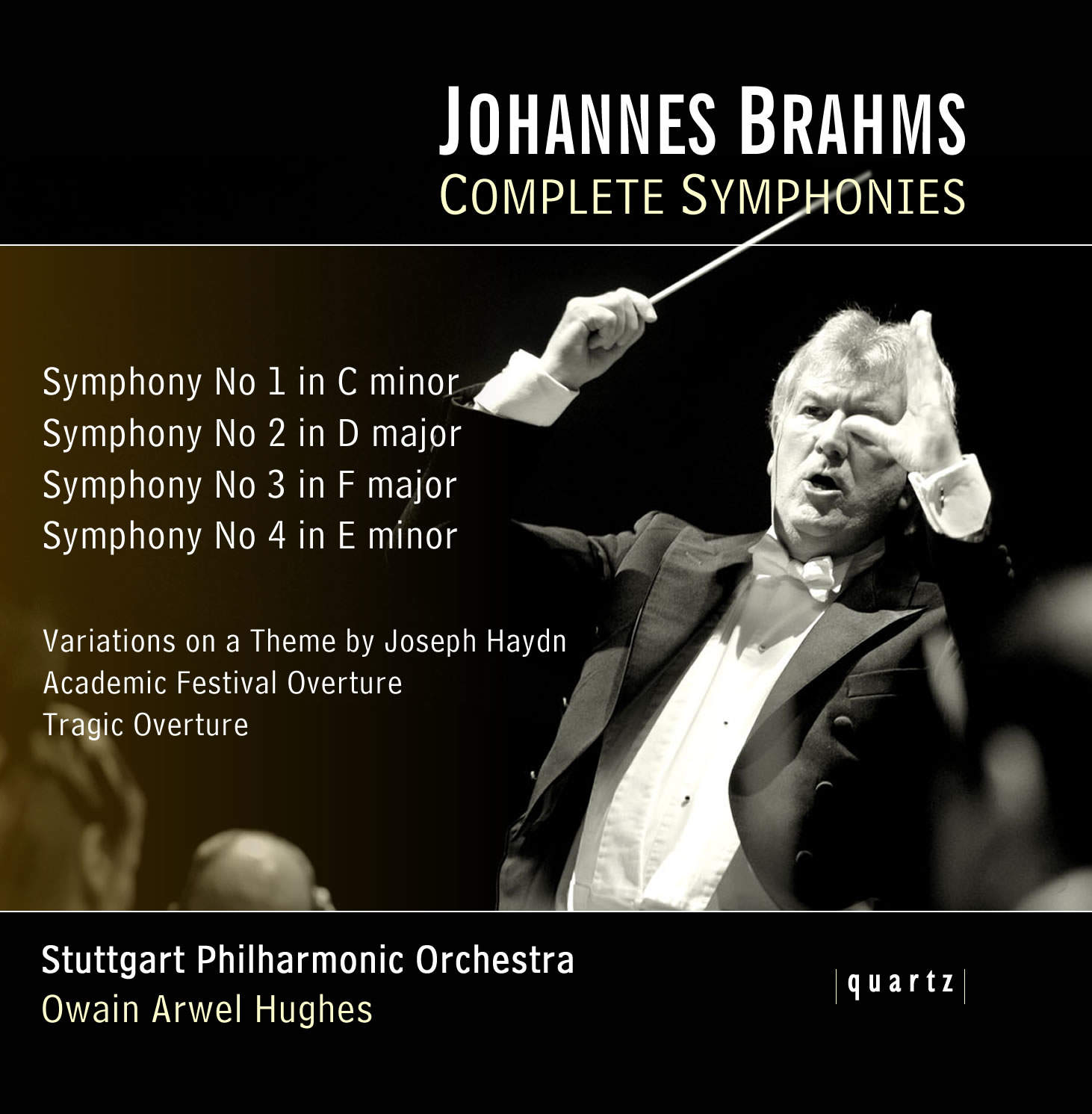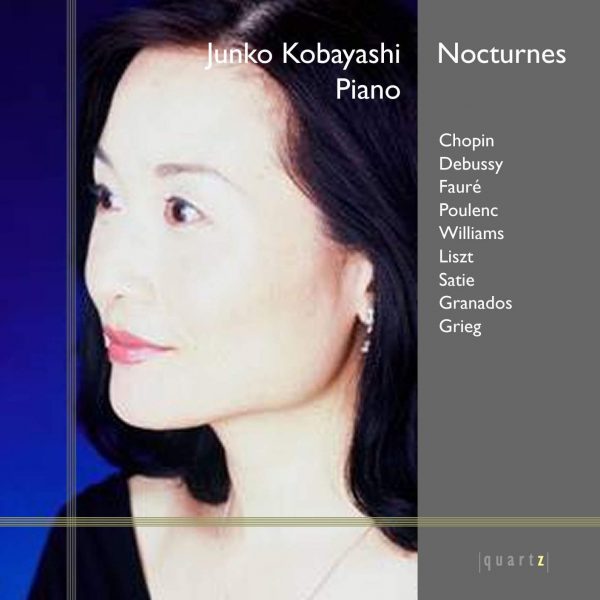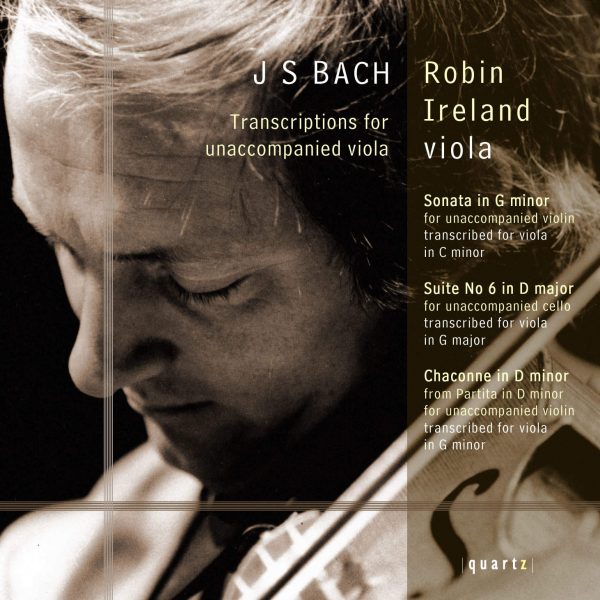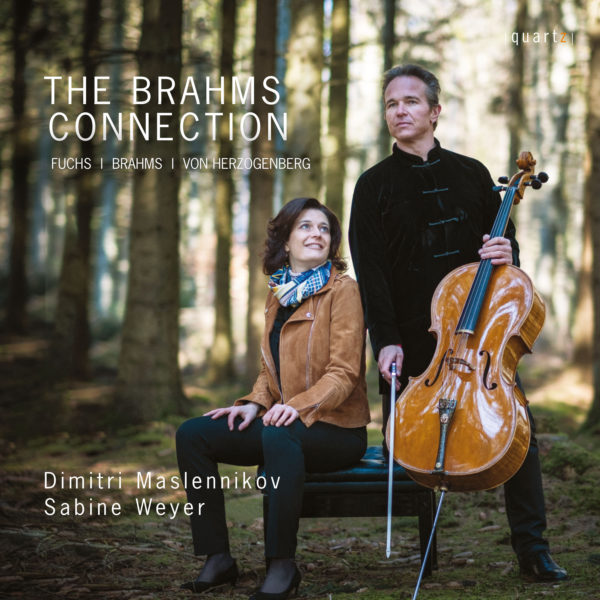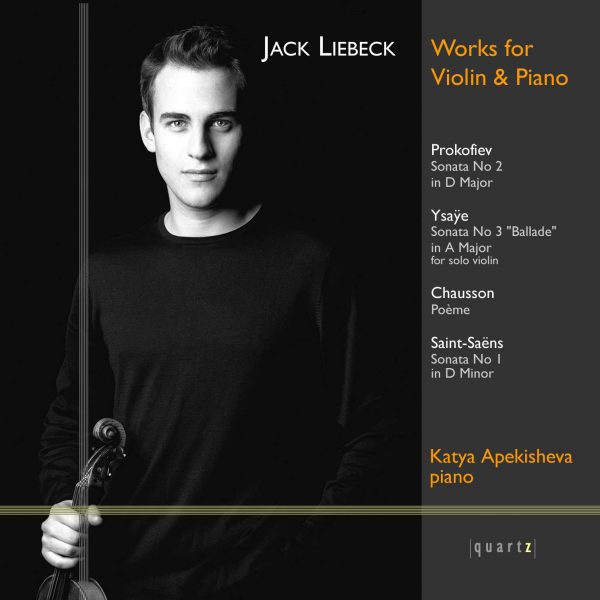Johannes Brahms – Complete Symphonies
£4.99 – £15.99
3 CD SET
Symphony No 1 in C minor, Op 68
Symphony No 2 in D major, Op 73
Symphony No 3 in F major, Op 90
Symphony No 4 in E minor, Op 98
Variations on a Theme by Joseph Haydn, Op 56a
Academic Festival Overture, Op 80
Tragic Overture, Op 81
An excellent value box set (3 CDs) featuring new recordings of Brahms’ complete symphonies as well as three of his best-known orchestral works. Performed here by the internationally celebrated Stuttgart Philharmonic Orchestra under the baton of the ever popular Owain Arwel Hughes.
About This Recording
Johannes Brahms was born in Hamburg in 1833 to a seamstress mother and musician father, who played horn and double bass among other instruments, and who encouraged his son’s obvious musical abilities. Despite his shyness, Brahms went on to befriend prominent musicians of the day including violinist Joseph Joachim and the Schumanns. Brahms”s devotion both to Robert and to Clara Schumann is well documented, and when, at age twenty, he played some of his works to the former, Robert declared them to be ‘disguised symphonies’. Brahms was still in his twenties when he started to plan his first symphony, but the completed work would not appear until 1876, by which time Brahms was 43. The Second Symphony followed in 1877 and was premiered on 30 December of that year; the Third and Fourth were written in 1883 and 1884-5 respectively.
Although Brahms saw himself as the successor to Beethoven (as did Bruckner and Wagner, for that matter), his musical language is distinctively his own, seamlessly traversing the spectrum of emotions within broadly ‘Classical’ forms; his symphonic writing encompasses a wide range of feeling, yet retains a seemingly effortless musical coherence. In the symphonies there is frequently the sense that his music may veer off into one of several emotional directions. Brahms sometimes playfully – imbues much of his material with a certain ambiguity, so that pathos, wit and drama may be present at any given moment, vying for precedence, until the composer guides one to emerge more powerfully than the others.
The slow introduction of the first movement of Symphony No 1 in C minor, op 68 suggests that the extraordinarily long gestation period of this symphony may have been partly due to Brahms’s concern to complete a work of real substance, one that would be a worthy successor to the symphonies of Beethoven. “You have no idea what it’s like to hear a giant’s footsteps marching behind you”, he wrote in 1870. The timpani pound out each individual beat while wailing strings struggle to move upwards and escape their gravitational pull. After a short moment of release and uncertainty, the pressure and tension mount again and momentum builds towards a brisk Allegro. It is difficult to think of a more “serious” opening to any work in the symphonic canon. The Allegro, while constantly driving forward briskly never abandons the overtly dramatic nature of the opening and it is not until the end that it finds a note of calm resolution/resignation.
The second movement, Andante sostenuto, is a complete contrast. Not only is it in a remote key, E major (four sharps instead of the three flats of C minor) but it takes on a much more lyrical, tranquil nature. The solo violin that emerges from the texture not only broadens the formal scope of the symphony by seeming to turn it momentarily into a concerto but it also broadens the emotional landscape, adding a tender and intimate element that contrasts with the large-scale drama of the opening movement.
While the first two movements of the symphony are concerned with forging a new symphonic path and with developing the scope of the symphony, the third movement, Un poco allegretto e grazioso, seems to look backwards towards the intermezzo, a form that Brahms had made his own. It shares the lightness of touch that one would normally expect from a scherzo in this position in a symphony but it has none of the fleeting playfulness and has much warmer instrumentation and a gently flowing rhythmic base.
After these two tender and intimate central movements, the last movement, Allegro non troppo ma con brio, counterbalances the weight of the first movement. It does this not, however, through the taut motivic interplay of the opening movement. The horn theme near the beginning (derived from Brahms’s notation of an alphorn according to a letter he wrote to Clara Schumann) indicates that this will be a much broader affair founded on longer, more developed melodies. The principal theme of the movement, heard initially in the strings, bears this out and has often been compared to the main theme of the finale of Beethoven’s Ninth Symphony (“any ass can see that!”, pointed out Brahms). Much has been made of the influence of Beethoven on Brahms’s Symphonies, and indeed the First Symphony has been nicknamed “Beethoven’s Tenth” on some occasions. However, a more immediate influence can surely be seen in the four symphonies of Schumann and, once you look beyond the overtly melodic influence of Beethoven on the First Symphony, there are many more formal and structural parallels to be found between Brahms’ First Symphony and, say, Schumann’s Fourth. The great brass chorales of the opening of the last movements being once such case in point.
The tranquil opening of Brahms‘s Symphony No.2, Op.73 sets the overall tone of the first movement, though there are moments of grandeur incorporated into the movement’s framework, with contrapuntal exchanges between the orchestral choirs building into majestic passages for the full ensemble. This use of dialogue is pervasive, but articulated with great subtlety, so that exchanges between different layers of the texture are woven in with a real lightness of touch. It has been said that Brahms wrote his symphonies with the sensibilities of one composing chamber music;
whether or not one accepts this assertion, his aptitude for idiomatic and controlled instrumental writing on the symphonic scale is manifest.
The subtle dialogue between orchestral sections continues in the second movement, which begins with an expansive string cantilena gently accentuated by chordal interjections. The flute joins the second statement of the theme, before a pared-down passage for horn and oboe, to which is added the flute and then the string section in counterpoint, building towards a passage for full orchestra. The essential warmth of the movement is punctuated by darker hints of chromaticism, and the music ebbs and flows between the delicacy of woodwind accompanied by pizzicato strings, and the increasing drama of more intensely textured passages.
The third movement opens with the wind choir supported by pizzicato strings. A pastoral oboe melody is later taken over by the fuller sound of the string section, but the overall sonority of the movement is airy and spacious, the full force of the ensemble rarely used, which might again justify the perceived relationship between Brahms’s symphonic writing and that of his chamber works. The exultant finale includes the rhythmic finesse, and deceptive syncopation, which has been a feature of the whole work.
The Third Symphony in F, Op.90, was premiered by Hans Richter and the Vienna Philharmonic Orchestra on 2 December 1883, and rapidly became one of Brahms’s most celebrated and frequently performed works – to the extent that the composer himself became quite overwhelmed by its popularity. The critic Eduard Hanslick described it as, of all Brahms’s symphonies, ‘the most compact in form, the clearest in the details’, and the first movement is indeed a fascinating instance of formal dexterity.
The central idea, a quotation from the music of Robert Schumann, is difficult to define either as ‘theme’ or ‘motif’. It recurs throughout the movement in different harmonic guises and at different textural levels, generating a structural unity that is at once simple in concept and sophisticated in execution. The powerful nature of this material is tempered by the gently meandering second subject group. This ability to create whole passages of music from small motifs was cited by Schoenberg in ‘Brahms the Progressive’, in which, rather unfashionably, he argued that Brahms’s ‘developing variation’, particularly in his chamber works, paved the way for the musical freedom of the 20th century.
The second and third movements of this symphony were adapted from material Brahms had written to Goethe’s Faust, and, whereas the outer movements centre on the key of F, the inner two take C as their main key area. The second movement’s mellow quality is created using rich wind sonorities and mellifluous, increasingly impassioned, string lines. The third movement is autumnal and introspective; indeed, the work has occasionally been subtitled the ‘Autumn Symphony’ – though never by Brahms himself.
This mood spills over into the finale, much of which is turbulent and troubled, but which also includes a transfigured version of the first movement’s central idea, demonstrating Brahms’s ability to unify the work not only within its movements but also on a macrocosmic scale. Heavy chords and grave contrapuntal writing dominate, but gradually the shadows begin to lift, eventually giving way, not to triumph, but to peace.
Brahms’s first three symphonies became, in his own lifetime, enormously popular and established him as the greatest symphonist of his day. It is perhaps difficult for us to understand why, therefore, the Symphony No 4 in E minor, Op. 98 was initially so badly received and why it took so long to establish itself as the great masterpiece it is widely considered to be today. Following its first outing, in a version for two pianos which Brahms played to a group of close friends from whom the composer would normally have expected to receive a warm reception, the critic Edward Hanslick wrote “I had the feeling that two enormously clever people were hitting each other with sticks.” It is maybe this “clevernessâ€, which to our ears sounds perfectly acceptable, that audiences found initially unsettling. From the opening canonic “waltz in 4/4” to the finale written entirely as a chaconne it is an immensely innovative work. In the end, though, audiences grew to appreciate it even during the composer’s lifetime and the composer was able to attend a rapturously received performance shortly before his death.
The first movement, Allegro non troppo, opens with a theme presented in canon (perhaps a nod towards Bach). Donald Francis Tovey says “No one experienced in great music could fail to see that long quiet opening sentence is the beginning of a great and tragic work.” This combined with two more themes, a long flowing melody first heard in horns and cellos and a third, fanfare-type melody. All are developed and recapitulated in a sonata-form structure.
The second movement, Andante moderato, opens with a stately horn fanfare but this soon gives way to a gentler, strolling version of the same theme its harmonies subverted into the phrygian mode – perhaps one of the elements that early audiences found problematic. The material develops into more forthright material based on triplets before returning to the calm and reserve of the opening.
The third movement, Allegro giocoso, has been called “perhaps the greatest scherzo since Beethoven” by Tovey. It uses the same level of taut thematic construction found in Beethoven’s own scherzos but uses a sonata-rondo form construction that would normally be found in a symphony’s finale. This seems to be quite an overt way of telling us that he was progressing once again beyond the normally accepted confines of the symphony. After all, what could follow as the finale if the finale’s usual structure has already been used?
Brahms’s solution was to use a passacaglia (essentially a set of variations over a repeated bass line) as the structure of the last movement. This, for many contemporary audiences, was one of the prime stumbling blocks of the symphony although Brahms dismissed this criticism by simply pointing out that Beethoven had used the same structural device in the finale of his Eroica Symphony. Another indication that this seeming break with tradition was actually rooted in tradition was the fact that he chose as his theme for the passacaglia one that had already been used by Bach in his Cantata No 150. The chaconne is laid out starkly in the brass at the beginning and is repeated some thirty times before the end, occasionally fading only to return clearly in the following variation. The extended coda section contains four expanded statements of the theme bringing to a close one of the greatest symphonies in the repertoire.
The Academic Festival Overture, Op. 80, was written in 1880 as a musical “thank you” to the University of Breslau, which had awarded him an honorary doctorate the previous year. The overture is cast in four continuous sections, Allegro-Maestoso-Animato-Maestoso, and Brahms simultaneously displays his sense of humour and his disdain for authority by building the whole work around, in his own words, “a very boisterous potpourri of student drinking songs”. It is, despite the chaotic nature of its prime musical source, a work of taut construction and has remained a popular work in the orchestral repertoire ever since.
The Variations on a Theme by Joseph Haydn, Op. 56a was written in 1873. Musicologists are broadly in agreement that the theme in question, the St Antony Chorale, was almost certainly not by Haydn at all but the name of the work has stuck with audiences and orchestras since. It was originally written for piano duet and later orchestrated by the composer who gave the orchestral version the Op. 56a catalogue number and the piano version the Op. 56b.
The theme itself is a slightly quirky ten-bar phrase comprising two five-bar phrases and this fact in itself probably appealed to Brahms. It is followed by eight variations which follow nearly exactly the phrasal structure of the original theme. After these variations there follows a finale which is a passacaglia over a ground bass of five bars derived from the principal theme. Brahms included in the finale a passage from Haydn’s Clock Symphony and it is ironical that this is probably the only original bit of Haydn in the whole piece.
Brahms wrote the Academic Festival Overture and the Tragic Oveture in the same Summer of 1880. “One laughs while the other cries”, he wrote. Various direct influences have been attributed to this work including the tragedies of Sophocles, which Brahms had been reading and which are also said to have been a major influence on his later symphonies, as well as Goethe’s Faust, a major influence on several composers of the nineteenth century. However, in all probability, the element of tragedy is not directly programmatic but, rather, the overture is concerned with generally austere and weighty themes as well as with the structural rigour (it is composed in an extended sonata form) usually associated with Greek theatre.
Track Listing
-
Johannes Brahms
- Symphony No 1 (i) Un poco sostenuto - Allegro
- Symphony No 1 (ii) Andante sostenuto
- Symphony No 1 (iii) Un poco allegretto e grazioso
- Symphony No 1 (iv) Adaio - Piu Andante - Allegro non troppo ma con brio
- Variations on a Theme by Haydn (i) St Anthony Chorale
- Variations on a Theme by Haydn (ii) Var. 1: Poco piu animato
- Variations on a Theme by Haydn (iii) Var. 2: Piu vivace
- Variations on a Theme by Haydn (iv) Var. 3: Con moto
- Variations on a Theme by Haydn (v) Var. 4: Andante con moto
- Variations on a Theme by Haydn (vi) Var. 5: Vivace
- Variations on a Theme by Haydn (vii) Var. 6: Vivace
- Variations on a Theme by Haydn (viii) Var. 7: Grazioso
- Variations on a Theme by Haydn (ix) Var. 8: Presto non troppo
- Variations on a Theme by Haydn (x) Finale: Andante
- Symphony No 2 (i) Allegro non troppo
- Symphony No 2 (ii) Adagio non troppo
- Symphony No 2 (iii) Allegretto grazioso (Quasi Andantino); Presto ma non assai
- Symphony No 2 (iv) Allegro con spirito
- Academic Festival Overture
- Tragic Overture
- Symphony No 3 (i) Allegro con brio
- Symphony No 3 (ii) Andante
- Symphony No 3 (iii) Poco allegretto
- Symphony No 3 (iv) Allegro
- Symphony No 4 (i) Allegro non troppo
- Symphony No 4 (ii) Andante moderato
- Symphony No 4 (iii) Allegro giocoso
- Symphony No 4 (iv) Allegro energico e passionato
